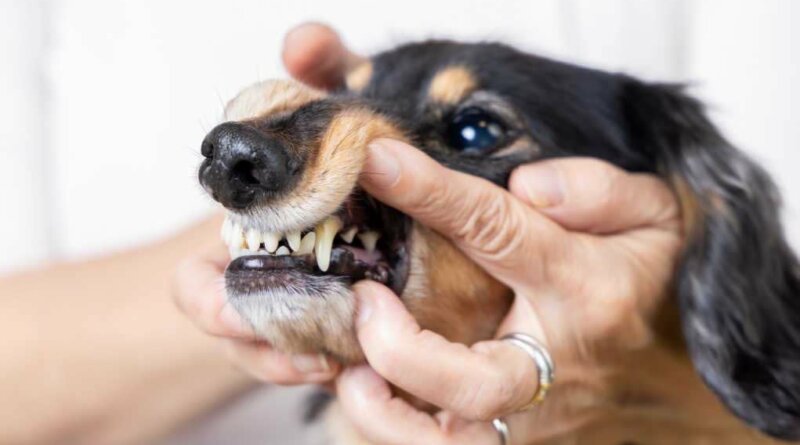Dog Gums with Dark Spots (And When To Be Worried) – Top Dog Tips
Do you see any dark spots inside your dog’s mouth?
Even though they are often overlooked, a dog’s gums are just as important to its mouth as its teeth.
Depending on their color and condition, they can reveal important details about your doggo’s general health—whether he is healthy or ill and what the discoloration can mean.
Paying attention to symptoms will help you respond to a range of canine health issues if you know what you are looking for.
However, very few dog owners realize the importance of gum care for sustaining their pet’s well-being.
So, in this article, we’ll discuss what healthy gums look like, gum problems to look out for, and what dog gums with dark spots mean.
This is to help you better understand whether everything is fine or if you have a problem on your hands.
By having a clear understanding of what it all implies, you will be able to ensure that you are giving your dog the best dental care possible.
What Color Should Your Dog’s Gums Be?
Healthy dog gums appear to be pink which is frequently compared to the color of cooked shrimp or bubble gum.
They should also be moist and somewhat shiny, signs that your dog is adequately hydrated.
You may also want to check your pup’s health by gently touching a spot on his gums with your index finger.
The color should return to pink from becoming white or pale pink after two seconds of releasing your grasp.
The capillary refill time, or CRT, is the amount of time it takes for the gums to turn pink once you press on them.
If this is the case, then your dog appears to be in good health and doesn’t seem to be suffering from any severe conditions.
While most dogs have pink gums, some breeds naturally have dark or black pigment in their gums or on the roof of their mouths.
Therefore, it’s crucial to routinely examine your dog’s gums to learn what is normal for them because this color might help determine your dog’s state of health.
RELATED: Healthy vs Unhealthy Dog Gums
Dog Gums with Dark Spots
It’s not unusual or rare for dogs to have colored mouths.
In fact, dogs of about thirty distinct breeds have pigmentation present at birth.
The black spots in a dog’s mouth can be a result of heavy pigmentation. Genetics or various oral health issues may be the cause of this coloring.
A small bit of color in the mouths of some breeds is completely normal.
The same is true because of their gene makeup, which makes the characteristic naturally present.
The following are some popular domesticated breeds that have been noted to have some pigmentation in their mouths:
Unless your pooch is one of the breeds listed above, look closely at the type of spots to determine whether genetics aren’t a factor.
Pigments that are flat black can be solely decorative.
Although dark spots on a dog’s gums are usually nothing to worry about, they could also be symptoms of dental diseases or oral cancer. However, this is not always the case.
What Causes Dark Spots on Dog Gums?
Melanin, which is just a random patch of additional pigmentation, causes these darker spots to appear.
It is vital to be aware of other factors that could be producing this discoloration if the black dots on the gums have not been present since birth.
There may be a problem if they have only recently appeared.
Normal Pigmentation
Similar to human freckles or birthmarks, pigmentation in dogs is something that some of them are merely born with.
Most often, genetics is to blame.
Pigmentation is common, much like in humans. Spots in dogs’ mouths are typically caused by intense coloring in their mucous membranes.
These small, flat spots on your dog’s mouth are also known as tiny melanin granules.
Keep in mind that these pigmented patches are always flat and never elevated.
They offer no harm at all and feel the same in your dog’s mouth as the rest of the surface.
It is advised to take your dog to the vet for a checkup if there is a raised spot in its mouth. This is especially true if your pet doesn’t typically have spots in its mouth.
Cyanosis
Black spots on the gums are not strongly related to the condition of cyanosis.
Dogs with cyanosis will have bluish discoloration on their gum due to a lack of oxygen.
The mixing of oxygenated and deoxygenated blood may be the result of some malfunction in the circulatory system.
It is advised to see a veterinarian right away to identify the underlying issue if you notice symptoms similar to these.
Gingivitis
Gum inflammation, also known as gingivitis, is the first stage of periodontal disease.
Also known as gingival inflammation, it is frequently brought on by a buildup of plaque and tartar along the gumline.
Gingivitis causes swelling and a black line around the gums, affecting several teeth.
The gingiva may even bleed when touched or when the patient eats.
Periodontal Disease
Periodontal disease in dogs, or dog gum disease, is brought on by oral bacteria that gradually destroy the tooth’s supporting tissues.
According to the American Veterinary Oral College, 80% of dogs begin to show signs of this disease by the age of three, while some may be more susceptible to it due to poor dental hygiene, genetics, and mouth structure.
Dogs often don’t exhibit symptoms of the ailment until it has progressed to an advanced stage since the infection hides beneath the gums.
Oral Cancer
Oral cancer may be present if your dog has abnormal growths in the mouth and black gums.
These growths can lead to hypoxia in your dog, which deprives various body organs of oxygen and results in the development of black gums.
Acanthomatous Ameloblastoma in dogs may be suspected if the black spots on the gums are raised.
Another condition that cause hyperpigmentation is Acanthosis Nigricans, which can only be cosmetic requiring no treatment at all.
But if in doubt, it’s best to double-check with your veterinarian to be safe than sorry.
When Should I Take My Dog to the Vet for Black Spots on the Gums?
Are the gums on your dog black? Perhaps a mix of pink and black?
This is likely normal, especially if this has been the case ever since he was a puppy.
There are numerous breeds with a lot of melanin in their mouths, with Chow Chows being the typical example.
Melanin is a dark pigment that is almost entirely black. Simply because this pigment is present, many dogs, particularly some mixed breeds, can have exceptionally dark lips and gums.
As a matter of fact, any dog with a black coat or skin may naturally have black gums as a regular variation.
While pigmentation is natural, it is still vital to watch these pups closely as they get older.
Melanoma, a potentially dangerous cancer, can develop from melanocytes which are cells that contain melanin.
It is always a good idea to consult a veterinarian whenever you observe a change in your dog to ensure that there is nothing to be concerned about.
In this manner, if it turns out to be something significant, you will discover it quickly.
If your dog had the spots since birth, it is unlikely that they have an underlying condition.
However, if you ever have any questions, consult with experts for guidance.
Visit a veterinarian right away if the black patches on your gums are any of the following:
- Increasing in size
- Raised
- Painful
- Stinky
- Causing any additional signs or symptoms
Other Gum Colors and What They Mean
Changes in gum color can be a sign of a variety of illnesses, including heart disease, liver failure, cancer, and dental diseases.
But before you panic, it’s important to understand exactly what those changes mean.
Blue or Pale Gums
The most frequent cause of blue gums in dogs is a disorder called cyanosis, which happens when the blood does not receive enough oxygen.
It might also be a sign of several fatal illnesses, such as:
- Choking
- Blood clots in the lungs
- Heart failure
- Infection within the chest cavity
- Low blood pressure
- Pneumonia
- Respiratory problems
Bright Red Gums
Your dog may bleed easily or experience pain if their gums are cherry-colored.
Particularly close to the gum line, one of the following conditions could be the cause of it:
- Certain types of cancer
- Dental disease
- High blood pressure
- Overheating or heatstroke
- Poisoning or toxicity
White or Pale Gums
Pale gums in dogs could indicate decreased numbers of red blood cells as a result of:
- Acute blood loss
- Anemia
- Shock or Trauma
Yellow Gums
Yellow gums are typically an indication of jaundice, which can be caused by:
- Liver problems
- Red blood cell damage
What Causes Dog Gum Infection?
When teeth aren’t brushed, a fuzzy, white substance known as plaque forms on them.
Plaque contains a lot of dangerous bacteria that can build up and mineralize into tartar, also known as dental calculus.
Rather than on the tooth’s smooth, natural surface, tartar makes it simpler for plaque to accumulate.
Inflammation of the gums will eventually arise from the plaque’s deeper penetration into the tissues supporting the tooth.
The soft tissues and bones that support the teeth will then be destroyed by the body’s typical inflammatory reaction to the plaque.
Your pet’s heart, liver, and kidneys could be affected if the infection enters the bloodstream.
Treating Dog Gum Disease
If you believe your dog may have gum problems, take him to the vet.
He will perform a complete dental examination and take dental X-rays while under general anesthesia to determine the best course of action.
The recommended course of therapy may range from a thorough cleaning of the tooth’s surface to eliminate plaque and tartar to periodontal surgery or even tooth extraction, depending on the results of the examination and X-rays.
Before starting an at-home gum-care program, it is crucial to have the problem treated by a veterinarian.
If the pet already has a dental condition that might be related to oral sensitivity, it might already be too late for toothbrushing to be of any assistance.
Therefore, it’s crucial to begin your dog’s preventative dental care when they’re young and still have a lot of healthy teeth in their mouth.
Preventing Unhealthy Gums in Dogs
For your dog to keep healthy gums, you must create a sound oral hygiene program.
Regular tooth brushing with dog-specific toothbrush and toothpaste will keep your dog’s teeth and gums in good condition.
By routinely brushing your dog’s teeth to remove plaque, you can avoid periodontal disease.
If brushing their teeth isn’t something your dog enjoys, there are a couple more options.
You can give your dog rubber chew toys or real bones to nibble on, such as rawhide or knucklebones.
These two techniques work well to remove food particles or plaque from the teeth, keeping the gums healthy in the process.
You could also give out dental treats. The purpose of dental chews and sticks is to maintain your dog’s teeth healthy and their breath fresh.
You should also plan routine dental examinations.
A Comprehensive Dental Health Assessment and Treatment (COHAT), which includes a full oral examination and cleaning in addition to the treatment of any existing disorders, can be very helpful for preserving your dog’s oral health.
FAQs about Dog Gums with Dark Spots
What do black spots in a dog’s mouth mean?
Pigmentation is what causes black patches. Patches on a dog’s tongue are simply pigmented skin cells, just like some breeds have darker “points” or spots.
The lips, nose, eye rims, paw pads, and toenails of a dog are considered points in terms of their coloration.
What do unhealthy gums look like in a dog?
Your dog’s gums may be red, swollen, or sensitive, all of which are signs that they might be infected.
It may have warm-to-the-touch gums in addition to bleeding or puss-oozing gums.
Gum infections can make your dog uncomfortable and, if left untreated, it can lead to more serious health issues.
What Are the Black Spots on My Dog’s Lips?
The American Kennel Club (AKC) states that pigmentation in your dog’s mouth extends beyond the tongue and gums. Your dog’s lips may also develop these black spots.
Oral pigmentation in dogs is not a cause for concern.
However, it is strongly advised that you take your dog to the vet for a checkup if these patches are elevated or discolored.
Dog Gums with Dark Spots: Final Thoughts
It should go without saying that your dog’s oral health should be one of the major concerns.
If you want to keep them from developing gum disease, tooth decay, or other oral problems, you should take care of them with routine checkups, a healthy diet, and the occasional dental stick.
Bright pink gums are typically connected with good oral hygiene.
So, if you notice that your dog has black spots or perhaps entirely black gums, you should be worried—and for good reason.
Dog gums with dark spots should not be ignored. Although in many instances, they are entirely normal.
Researching your dog’s breed is equally as vital as being cautious if you feel there is a problem with their mouth.
If at all feasible, learn more about their ancestry to determine whether or not they have a more serious pigmentation problem than just black gums and blotches in their mouth.
READ NEXT: Gum Infection in Dogs: Signs, Causes & Treatments









